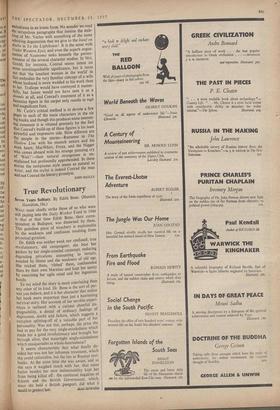Style and Rapt Fuzz
Conrad: Sea Stories (Typhoon, Youth, The Nigger of the Narcissus, The Secret Sharer). (Hart-Davis, 12s. 6d.)
Joseph Conrad and His Characters. By Richard Curie. (Heinemann, 21s.)
ONE of the many illuminating things which Con- rad told Mr. Curie was that Lord Jim, which was begun as a story about the pilgrim ship episode, should have remained in that form. Most of us would agree. It would have ranked beside Typhoon, Youth, Falk, The Secret Sharer and The Shadow Line, most of which are collected together in this new edition, and which represent Conrad's central achievement. As it is, Jim's fix is sent grinding on into another dimension: he is squeezed dry by Conrad's inexorable conscien- tiousness. The preparations for his death are as elaborate and prolonged as the last act of Tristan and Isolde, whereas we should have taken leave of him as we do of the secret sharer, striking out into the darkness as the ship rounds the ominous cliff of Koh-Ring.
This is a way of saying that Conrad is really closer to Dickens and Chekhov than to his self- appointed grand maitre, Henry James. Like the master he saw achievement in terms of curious difficulties, and his labours over Victory and The Secret Agent endeared them to him correspond- ingly; what came more simply had less appeal for him, but for us it is the other way round. Not that anything came easily—the marvellous rigours of his style saw to that—but one can't help thinking that the rigours are more absolutely successful when exercised on some less ambitious occasion. He is at his best in sonatas and quartets, not in symphonies. The engrossed contriver of the full- scale subject is a fascinating Conrad, but a Con- rad who hovers always on the verges of unreality. The Secret Agent. is damagingly reminiscent of The Princess Casamassima; in spite of its grue- some subject it is an unmoving book, and Conrad confirms this impression by telling us that he wished to attempt the sustained treatment of melodrama in an ironic form. No wonder we read the scrupulous paragraphs that itemise the stab- binga Mr. Verloc with something of the same admiring degustation that we give to the bwuf en Faube in To the Lighthouse! It is the same with Under Western Eyes, and even the superb organ- isation of Nostromo sinks beneath the porten- tousness of the several character studies. In Mrs. Gould, for instance, Conrad seems intent on some unrelinquishable significance, but it turns out that `the loneliest woman in the world' in fact embodies the very familiar concept of a wife Whose husband is more wedded to his work than to her. Trollope would have conveyed it master- fully, but James would not have seen it as a donnee at all, and Conrad's treatment of it as a Jamesian figure in the carpet only results in rapt and magnificent fuzz. Mr. Curie's critical method is to devote a few Pages to each of the main characters in the six big books, and though this produces some interest- ing comment it is vitiated precisely by the fact that Conrad's build-up of these figures is his least Powerful and impressive side. How different are the people in the stories—Ransome in The Shadow Line with his staunch nature and his Weak heart; MacWhirr, Freya, and the Nigger Who comes aboard with his strange punning cry of 'Wait!'—their natural strangeness is un- explained but profoundly apprehended. In these stories the sumptuous style seems as natural as Water, and the stylist is indeed Conrad the man and not Conrad the literary proselyte.
JOHN BAYLEY







































 Previous page
Previous page